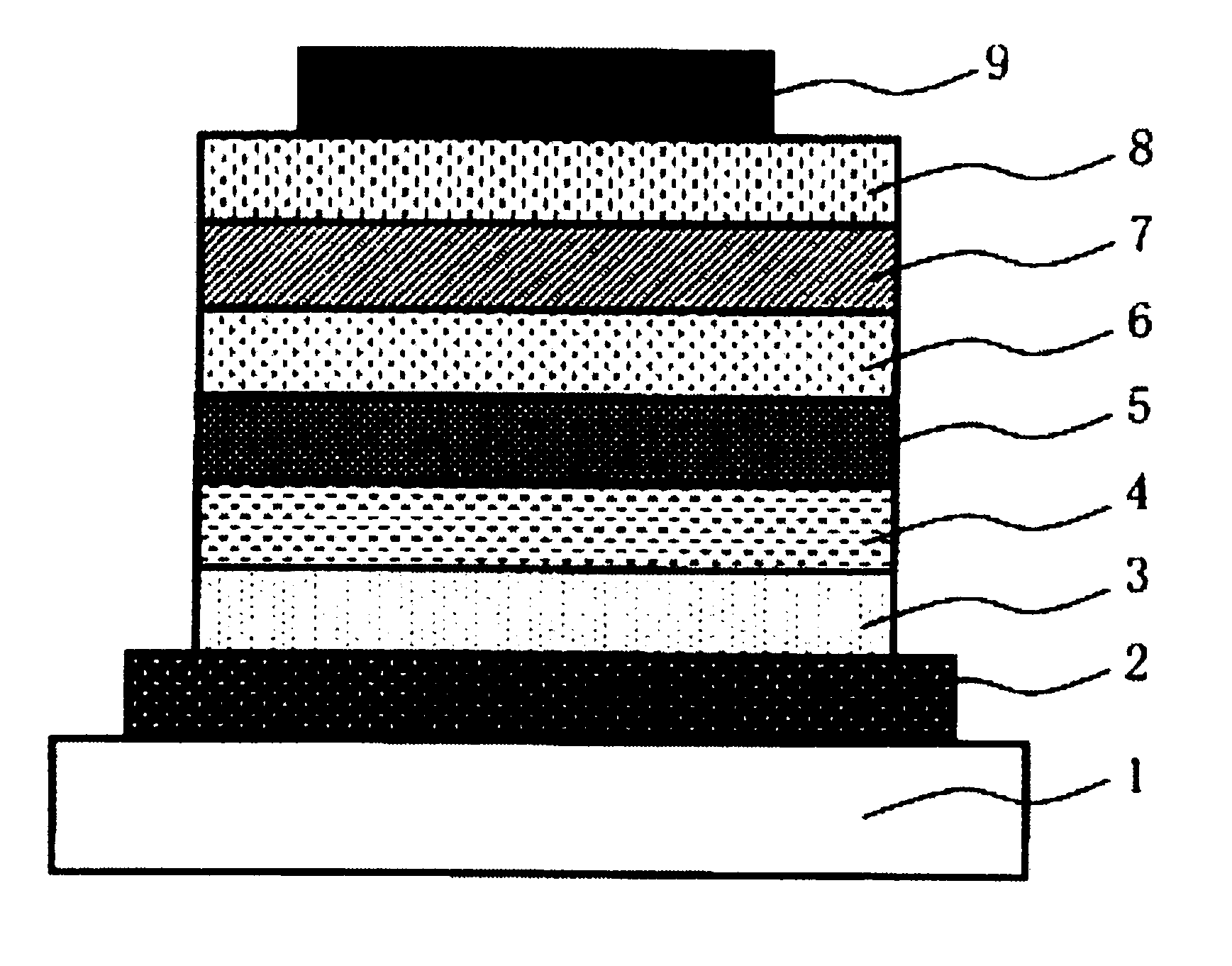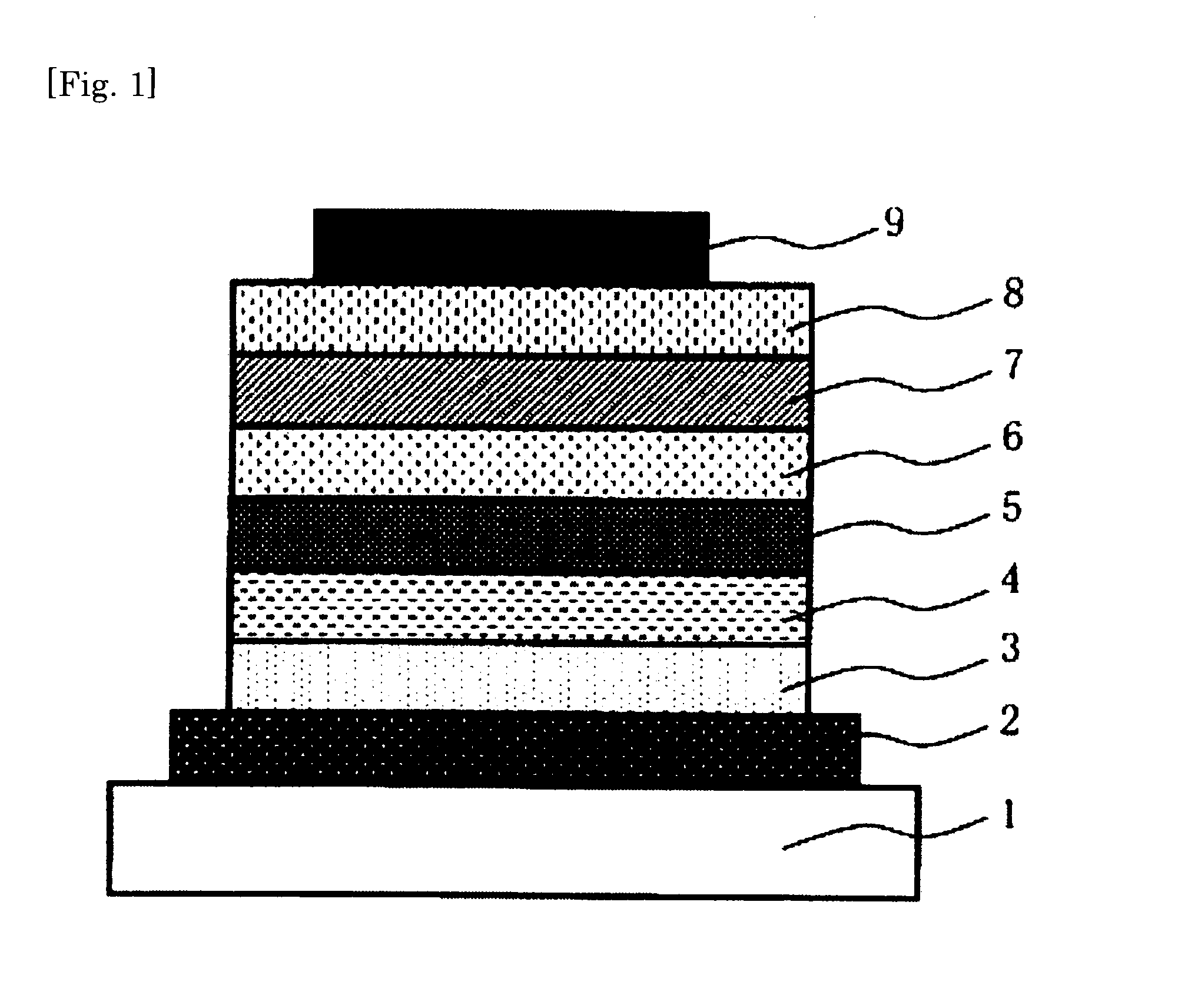Charge-transporting polymer, composition for organic electroluminescent element, organic electroluminescent element, organic el display, and organic el lighting
- Summary
- Abstract
- Description
- Claims
- Application Information
AI Technical Summary
Benefits of technology
Problems solved by technology
Method used
Image
Examples
synthesis example 1
[0357]
Target Substance 1
[0358]Dichlorobis(acetonitrile)palladium(II) (212 mg; 0.03 equivalents) and copper iodide (104 mg; 0.02 equivalents) were introduced into a 200-mL four-necked flask through which nitrogen was kept passing. Dioxane (75 mL) which had been degassed beforehand by nitrogen bubbling was introduced thereinto, and the mixture was stirred. Tri-t-butylphosphine (331 mg; 0.06 equivalents) was added to the resultant liquid, and this mixture was stirred at room temperature for 15 minutes. To the resultant solution were added diisopropylamine (3.31 g; 1.2 equivalents), 4-bromobenzocyclobutene (5.00 g; 1.0 equivalent), and 1,7-octadiyne (20.3 g; 7.0 equivalents). The resultant mixture was reacted at room temperature for 9 hours. The reaction mixture obtained was heated at a bath temperature of 60° C. under a reduced pressure of 400 Pa to distill off low-boiling substances therefrom. Thereafter, saturated aqueous sodium chloride solution (50 mL) and 1-N hydrochloric acid (5 ...
synthesis example 2
[0359]
[0360]m-Iodonitrobenzene (3.64 g; 1.1 equivalent), potassium carbonate (5.06 g; 2.75 equivalents), copper iodide (111 mg; 0.044 equivalents), triphenylphosphine (307 mg; 0.088 equivalents), and 5% Pd / C (623 mg; 0.022 equivalents in terms of palladium amount) were introduced into a 100-mL four-necked flask through which nitrogen was kept passing. A dimethoxyethane / water=1 / 1 mixed solvent (95 mL) which had been degassed beforehand by nitrogen bubbling was introduced thereinto, and the mixture was stirred at room temperature for 1 hour. To this liquid was added a solution prepared by dissolving the target substance 1 (2.77 g; 1.0 equivalent) in dimethoxyethane (2 mL). The resultant mixture was reacted for 7 hours with heating on a 70° C. bath (internal temperature, 63° C.). The reaction mixture obtained was filtered through a Celite and then concentrated with an evaporator. To the concentrate was added 25 mL of 1-N hydrochloric acid. This mixture was extracted with ethyl acetate ...
synthesis example 3
[0361]
[0362]The target substance 2 (2.31 g), 15 mL of tetrahydrofuran, and 15 mL of ethanol were introduced into a 100-mL eggplant type flask, and the solid was dissolved. To this solution was added 1.07 g of Raney nickel (R-200, manufactured by Nikko Rica Corp.) as a hydrogenation catalyst. After the atmosphere in the flask was replaced with hydrogen three times, the mixture was reacted at room temperature for 35 hours in a hydrogen atmosphere. The liquid reaction mixture was filtered through a Celite and concentrated with an evaporator to obtain 2.8 g of a crude product. This crude product was purified by silica gel column chromatography (solvent: n-hexane / ethyl acetate mixed solvent), thereby obtaining target substance 3 (1.72 g) as white acicular crystals (yield, 80.1%; purity determined by liquid chromatography, 99.1%).
PUM
| Property | Measurement | Unit |
|---|---|---|
| Speed | aaaaa | aaaaa |
| Speed | aaaaa | aaaaa |
| Wavelength | aaaaa | aaaaa |
Abstract
Description
Claims
Application Information
 Login to View More
Login to View More - R&D
- Intellectual Property
- Life Sciences
- Materials
- Tech Scout
- Unparalleled Data Quality
- Higher Quality Content
- 60% Fewer Hallucinations
Browse by: Latest US Patents, China's latest patents, Technical Efficacy Thesaurus, Application Domain, Technology Topic, Popular Technical Reports.
© 2025 PatSnap. All rights reserved.Legal|Privacy policy|Modern Slavery Act Transparency Statement|Sitemap|About US| Contact US: help@patsnap.com



